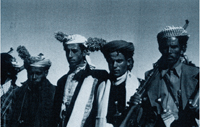
Zamil in war and wedding ceremonies [Archives:2008/1171/Last Page]
July 10 2008
 |
[email protected]
A Zamil is a two-line poem that's considered one of the main popular and tribal conventions used on special occasions in northern and eastern Yemen, being used at both wedding parties, as well as during war mediation. Zamil usually is composed at the time on the spot and conveys a message particular to that occasion.
As 63-year-old Khawlan sheikh Ali Ahmed Al-Sharafi explains, “Zamil is two lines of poetry performed by a chorus of men to express congratulations, consolation or give advice in the event of problems or war.”
Zamil verses never exceed two lines, with – at most – between six to 15 men addressing the audience as they perform it. Many different melodies are used for Zamil, which is sung, not chanted.
According to Dr. Steven Caton, a professor at Harvard University in the United States, only one poet is responsible for creating the Zamil text on the spot. During the performance, the men are divided into two groups, with one group reciting the first line, while the other recites the second, as they take turns singing the Zamil.
A common convention is to begin a poem by addressing a messenger, represented by the image of a bird or the wind, which the poet asks to carry his message.
As Caton writes in his definitive book on the subject, “The Peaks of Yemen, I Summon,” Zamil can begin as follows:
“Ya ta'ir, ya azim wa gati lil marahil // tayyir wa khabbir Bin Jalal.”
“O bird, O messenger, O crosser of the journey's stages, // fly and inform Bin Jalal.”
“Jiina bi akhsham al-madala wa al-jaramil // silah Khawlan Al-Tiyal.”
“We've come with the nostrils of guns and rifles, // the weapons of Khawlan Al-Tiyal.”
As Caton writes in his book, “The Zamil audience is passive. What it sees is ranks of men marching toward it like an army unit on parade in a dusty riverbed. What it hears is their tribal regalia, rifles slung over their shoulders as they walk in brisk step, sometimes hand-in-hand.”
He further explains, “A Zamil performance may include poetry and instrumental music, as well as song and dance united as a whole. At wedding ceremonies and religious festivals, a couple of servant drummers may precede the marchers. The musical drumming is for the performance and the dance, each involving a row of men moving in coordinated steps.”
Zamil in wartime
However, Zamil's main significance is apparent during war, which often breaks out between two or more tribes. During this time, Zamil is used as a medium to address a problem and suggest solutions to the warring parties.
“In Yemen, the role of the state in rural areas during tribal wars is too weak, so people are used to solving their problems themselves,” says Mohammed Zubair, a sheikh in Sana'a governorate's (the Capital Secretariat) Khawlan district.
“If a war breaks out between two or more tribes, the other neighboring tribes join together and go to the struggling tribes to attempt to mediate between them and solve their quarrel, performing Zamil in chorus upon their arrival,” he explains.
According to him, the men usually begin Zamil by praising the party to be addressed, reminding them of their good deeds and scolding them for waging war. They then suggest solutions to the conflict. In response, the addressed party creates a new Zamil in which they may accept or refuse the mediator's advice and help. “Just imagine that a big war sometimes is solved by two or three lines of poetry!” Zubair remarks.
Another of Caton's examples of mediation Zamil in wartime goes like this:
“Ya dhi al-masani dhi badeti, // ma shi ala sharid malamah.”
“O, these fortresses towers that have appeared before me, // there's no blame upon the fugitive.”
“Quli li Yahya bin Mohammed // ba naltagi yawm al-qiyamah.”
“Tell Yahya bin Mohammed // we'll meet on the Day of Resurrection.”
Zamil in weddings
Zamil is used at men's wedding parties to express congratulations, as well as praise both the guests' and the hosts' hospitality and traditions. The first Zamil performance during a wedding is during the arrival of the guests, who utter several verses in chorus, thereby expressing their happiness to be guests at the occasion and extending their thanks to their hosts for inviting them.
“Wedding guests usually come in groups and every group performs Zamil upon their arrival, congratulating the groom and his relatives and praising the guests, traditions and customs such as hospitality and courage,” explains Ahmed Al-Daba, a 45-year-old Khawlan tribesman.
After the guests finish their Zamil, their hosts then receive them with a new Zamil, welcoming the former exuberantly and thanking them for coming. During the wedding party, several Zamil poems are performed, the most important of which is the one bidding farewell to the bride's relatives. In this Zamil, several of the groom's guests and relatives choose the Zamil's words and melody very carefully.
Despite changes that have occurred throughout Yemen's development over the past 50 years, Zamil still is used as one of the main mediums to express feelings and thoughts within tribal communities.
——
[archive-e:1171-v:16-y:2008-d:2008-07-10-p:lastpage]


